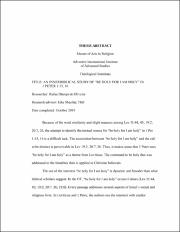An Innerbiblical study of "be holy for I am holy" in 1 Peter 1:15,16
Abstract
Because of the word similarity and slight nuances among Lev 11:44, 45; 19:2; 20:7, 26, the attempt to identify the textual source for “be holy for I am holy” in 1 Pet 1:15, 16 is a difficult task. The association between “be holy for I am holy” and the call to be distinct is perceivable in Lev 19:2; 20:7, 26. Thus, it makes sense that 1 Peter uses “be holy for I am holy” as a theme from Leviticus. The command to be holy that was addressed to the Israelites then is applied to Christian believers.
The use of the intertext “be holy for I am holy” is dynamic and broader than what biblical scholars suggest. In the OT, “be holy for I am holy” occurs 6 times (Lev 11:44, 45; 19:2; 20:7, 26; 21:8). Every passage addresses several aspects of Israel’s social and religious lives. In Leviticus and 1 Peter, the authors use the intertext with similar
2
wording. However, in 1 Pet 1:15, the author redesigns the intertext. Since each use of “be holy for I am holy” has distinctive features, every passage needs an individual study.
A study that considers options of source for the intertext “be holy for I am holy” in 1 Pet 1:15, 16 enables, to a certain extent, the understanding of 1 Peter’s argument. However, further contribution will be found by addressing the development of the intertext. The dynamic use of the “be holy for I am holy” should be addressed.
This research approached the text through innerbiblical exegesis which studies how a recent text reapplies or reinterprets an earlier one. Quotations are the most studied objects of this method. The method considers terminology, structure, and theme with a special emphasis on the historical and literary aspects of the text. Innerbiblical exegesis excels in appreciating the tradition and the divine revelation of the text.
To begin with, the nature of the study and the processes involved to solve the problem were presented. After that, common and distinctive features among the uses of “be holy for I am holy” were surveyed in Leviticus. Then, these features were assessed and the issues surrounding the uses of the intertext were categorized. At the end, the use of “be holy for I am holy” in 1 Pet 1:15, 16 was theorized.
This study presented an alternative theory on the use and the source of “be holy for I am holy” in 1 Pet 1:15, 16 based on the dynamics of common and distinctive features on the uses of the intertext in Lev 11:44, 45; 19:2; 20:7, 26; 21:8. Peter uses the theme of holiness from Leviticus which is embedded in the words “be holy for I am holy.” In v. 15, “as the one who called you is holy, you also be holy” is an allusion to the adaptive refrain “be holy for I am holy” from Leviticus that empowers Peter’s argumentation on Christian behavior. In v. 15, the author uses the dynamics and patterns previously applied to the intertext in Leviticus. In v. 16, “be holy for I am holy” is the 3 basic frequently used words in God’s refrain in Leviticus. In this last verse, “be holy for I am holy” is a reduced quotation which conveys the theme of holiness with a generic ascent.


